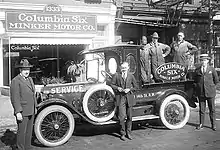Rainier Motor Car Company
Rainier Motor Car Company was an American automobile manufacturer founded in 1905 by John T. Rainier in Flushing, New York. The company specialized in manufacturing large and luxurious automobiles. In 1909, the company was bought by General Motors who maintained the brand until 1911.[1]
 | |
| Type | Private (1905–09) Subsidiary (1909–11) |
|---|---|
| Industry | Automotive |
| Genre | luxury passenger car |
| Fate | Purchased by General Motors, discontinued in 1911 |
| Founded | 1905 |
| Founder | John T. Rainier |
| Defunct | 1911 |
| Headquarters | , |
Area served | United States |
| Products | Automobiles, parts |
| Parent | General Motors |
History
Rainiers were big, conventional and solidly built automobiles with much power. They earned local success with hill climbs and mountain races. The company was also one of the first ever who offered a limited one-year guarantee on "use without repair expenses".
They were first headquartered in John Rainier's dealership for Vehicle Equipment (V.E.) Automobiles. James G. Heaslet became chief engineer for Rainier, a position which he held for the whole time of production.

In the beginning, Rainiers received their final assembly in Flushing.[2] Chassis were delivered by the Garford Motor Truck Company of Elyria, Ohio which specialized in automobile components and built chassis for several car manufacturers, most prominently Studebaker.
During 1907 it became obvious that Garford and Studebaker would intensify their cooperation and that delivery of frames for Rainier was not secure. Rainier decided therefore to build its cars completely in-house. A new plant was erected in Saginaw, Michigan which already was considered an early center of automobile manufacturing. It opened in time for the production of 1908 models.
When Rainier in 1907 was hit by a short but hard economic recession this came at the worst moment. After the assembly of ca. 300 automobiles in Saginaw, Rainier was petitioned into involuntary bankruptcy because there was not enough cash to meet wages and material cost. Assets always were higher than liabilities but that did not count. The company was auctioned on January 25, 1909, and went for $20,000 to attorney George C. Comstock who tried to secure it for John Rainier. That failed due of lack of funds, and William C. Durant bought it from Comstock for General Motors.

GM organized a new company in Saginaw for manufacturing the Rainier and parts for the other recently acquired luxury car, the Welch Motor Car Company and it is a little less expensive companion make, the Welch-Detroit. It was named the Marquette. Business was under control of Buick management which itself was part of GM, too. Things changed in September, 1910, when Durant had to leave GM after financial trouble arose after his aggressive policy of expansion with acquisitions of many companies.
At first, few changes occurred at Rainier although the mother company's new management practiced a straight course of consolidation which led to the demise of several makes – including the Welch but not the Welch-Detroit. The turnaround was tried until 1911, then production of the Welch-Detroit, including machines and tools, was transferred from Pontiac, Michigan to Saginaw.
For 1912 a last attempt was tried by developing new models that used parts of both the Welch-Detroit Model S, 45/50 HP, and the Rainier Model F, 50 HP. They were marketed as the Marquette 40 HP and 45 HP, respectively, and sold for prices that started at $3,000 and $4,000. The very last cars were then offered as Peninsulars, but production ceased at the end of 1912.
GM would use the brand name Marquette again for a junior Buick automobile in 1930, and would use the "Rainier" name on the rebranded Oldsmobile Bravada/Buick Rainier when Oldsmobile was discontinued in 2003.
Model overview
| Series | Designation | Wheelbase | Coachwork | base price in US$ |
|---|---|---|---|---|
| 1905-06 | Model A; 22/28 HP | 98 | Touring car, 5-pass. | 3,500 |
| 1906 | Model B; 30/35 HP | 104 | Town Car, 7-pass. | 4,000 |
| 1907 | Model C; 30/35 HP | 104 | Touring car, 5-pass. | 4,250 |
| 1907 | Model C; 30/35 HP | 104 | Landaulet, 7-pass. | 4,250 |
| 1908-09 | Model D; 40/50 HP | 104 | Touring car, 5-pass. | 4,500 |
| 1908-09 | Model D; 40/50 HP | 104 | Limousine, 7-pass. | 5,500 |
| 1910 | Model F; 50 HP | 119 | Enclosed Touring car, 7-pass. | 4,500 |
| 1910 | Model F; 50 HP | 119 | Touring car, 7-pass. | 4,500 |
| 1910 | Model F; 50 HP | 119 | Baby Tonneau, 5-pass. | 4,500 |
| 1910 | Model F; 50 HP | 119 | Close-coupled Touring Car, 5-pass. | 4,500 |
| 1910 | Model F; 50 HP | 119 | Limousine, 7-pass. | 5,750 |
| 1910 | Model F; 50 HP | 119 | Landaulet, 7-pass. | 5,850 |
| 1911 | Model F; 50 HP | 120 | Roadster, 2-pass. | 4,250 |
| 1911 | Model F; 50 HP | 120 | Close-Coupled Touring car, 4-pass | 4,250 |
| 1911 | Model F; 50 HP | 120 | Special Touring car, 7-pass. | 4,250 |
| 1911 | Model F; 50 HP | 120 | Regulation Touring car, 7-pass. | 4,500 |
| 1911 | Model F; 50 HP | 120 | Close-Coupled Touring car, 5-pass. | 4,500 |
| 1911 | Model F; 50 HP | 120 | Limousine, 7-pass. | 4,600 |
| 1911 | Model F; 50 HP | 120 | Landaulet, 7-pass. | 4,600 |
Bibliography
- Clark, Henry Austin, Jr. Kimes, Beverly Rae (ed.). Standard Catalogue of American Cars (2nd ed.). Iola, Wisconsin: Krause Publications. ISBN 0-87341-111-0.
References
| Wikimedia Commons has media related to Rainier vehicles. |
.svg.png.webp)